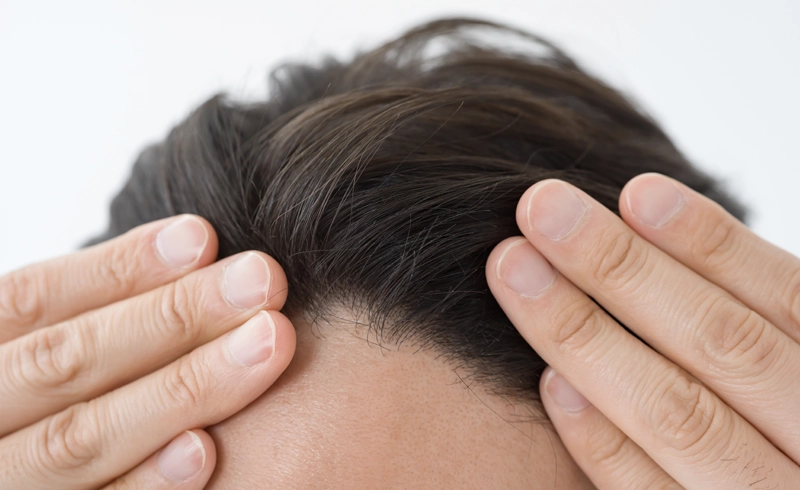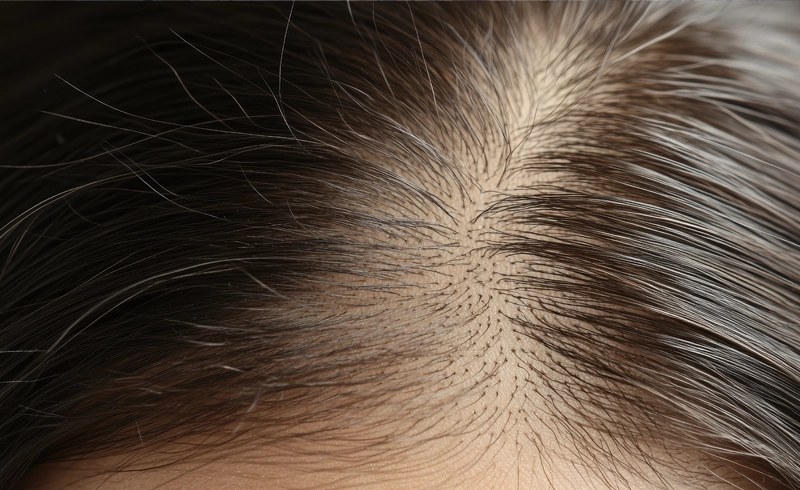Female Pattern Baldness: An In-Depth Look at Androgenetic Alopecia in Women


Female pattern hair loss affects more than 21 million women in the United States and is the most common type of hair loss that adult women face. Amongst healthy women, up to 38% experience some degree of hair loss on the front or side of the scalp, and more than one in four women over the age of 50 experiences significant hair loss.
Hair loss in women often causes more psychological distress than it does in men. Because female pattern hair loss is progressive, meaning it will get worse without treatment, it is important for women to understand the best ways to address their hair loss.
What is female pattern hair loss?
Female pattern hair loss refers to a reduction in the density of hair over the crown of the head and front of the scalp without significant loss of the front hairline. There are three specific patterns of hair loss that are commonly observed:

- Widening of the midline. This pattern involves greater thinning in the front of the scalp than in the back of the scalp, which leads to a triangular shape that resembles a Christmas tree. As a result, this pattern of hair loss if often referred to as the “Christmas tree pattern.”
- Balding of the crown. Balding of the crown makes the part width appear larger. When balding of the crown occurs, the frontal hairline is preserved.
- Overall thinning. A pattern of overall thinning resembles what is most often associated with male pattern baldness, where thinning is most noticeable on the sides of the scalp, toward the front of the head. This type of hair loss sometimes occurs in women who first experience balding of the crown after they go through menopause.
There are several classification systems to evaluate the severity and extent of hair loss, but a system known as the Ludwig scale is the most common tool used to assess female pattern hair loss. According to this scale, severity of hair density reduction falls into one of three grades. For those with Grade I hair loss, there may be noticeable hair thinning on the crown of the head, but thinning does not extend more than about three centimeters behind the front hairline. Grade II refers to more pronounced hair loss, and those with Grade III have areas of complete baldness.
What makes women suffer this type of hair loss?
Female pattern hair loss is not fully understood, but there appear to be several factors that can increase one’s chances of experiencing this type of hair loss. These factors include:
- Genetics. Scientists know that genetics plays a role in male pattern hair loss, which is also referred to as androgenetic alopecia. Though there is less evidence that genes strongly contribute to female pattern hair loss, genetics is likely one factor that can raise a woman’s chances of undergoing hair loss.
- Aging. The risk of female pattern hair loss increases with age. While it occurs in roughly 12% of women in their 20s, the likelihood that a woman who surpasses the age of 80 will experience this type of hair loss is over 50%. Indeed, most women with female pattern hair loss develop the condition after menopause.
- Hormone Imbalance. Female pattern hair loss is often one of the first signs that allows clinicians to diagnose women with androgen excess. Androgens are sex hormones that are known to be intimately connected to male pattern baldness, and higher-than-normal levels of these hormones appear to increase the risk for female pattern hair loss as well.
- Things like diet and exercise can contribute to female pattern hair loss. For example, research has pointed to a potential role for certain vitamins and nutrients in the development of female pattern hair loss. Vitamin D deficiency and iron deficiency are frequently observed in women with female pattern hair loss. Several other micronutrients and amino acids are implicated in this disorder as well, including vitamins A, B3, and E, folic acid, biotin, zinc, and selenium. There are also data that suggest that frequent exercise can contribute to hair loss, possibly because of the impact exercise has on sex hormones.
What can we do to fight female pattern hair loss?
Minoxidil, a topical therapy, was approved by the United States Food and Drug Administration (FDA) for use in female pattern hair loss in 1991, but there is mixed evidence regarding whether this treatment can improve hair loss. In cases where Minoxidil appears beneficial, improvements are not observed for at least the first three months of treatment. Additionally, this treatment can lead to contact dermatitis, and patients often experience increased hair loss using this intervention.
Inhibiting the hormone dihydrotestosterone, known as DHT, has been shown to be beneficial in both male pattern hair loss and female pattern hair loss. DHT is naturally produced within the body when testosterone is converted into it. A drug called finasteride, which inhibits this conversion, is approved by the FDA for use in men. Indeed, it is highly effective in men with male pattern hair loss.
Finasteride is significantly teratogenic, meaning that it put fetuses at risk if the mother is taking the drug. The drug is also associated with unwanted side effects including depression, nausea, hot flashes, and headaches.
Though its efficacy in women is debated, with most data suggesting that finasteride may help women with female pattern hair loss when used in much higher doses than used in men, finasteride is not approved for use in female pattern hair loss. One thing likely preventing its approval for use in women is that finasteride is significantly teratogenic, meaning that it put fetuses at risk if the mother is taking the drug. The drug is also associated with unwanted side effects including depression, nausea, hot flashes, and headaches.
Luckily, there is evidence that low level light therapy is both safe and effective in female pattern hair loss, and the FDA has approved this technique for combatting hair loss. Light therapy offers a natural way to inhibit DHT without the adverse side effects. Innovative technologies that use LED can also overcome technical limitations of lasers to provide full scalp coverage to improve outcomes. More research into the effects of light therapy on female pattern hair loss should help to clarify the specific benefits that this approach can offer the many women diagnosed with this condition.
